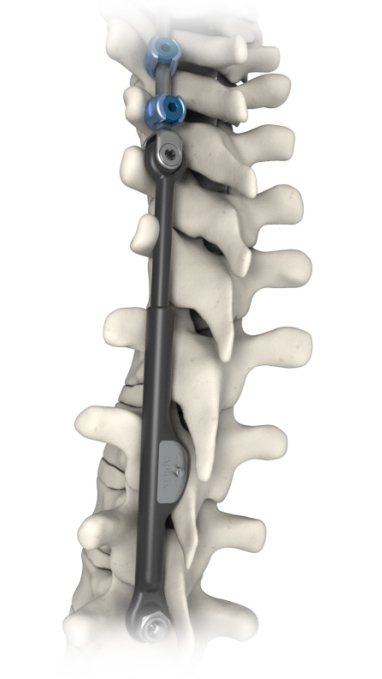Early Onset Scoliosis Surgery
Adolescent Scoliosis Surgery Overview
While non-surgical options for treating scoliosis are obviously preferred, once curves progress to around 45-50°, surgery becomes the best option. Fortunately, patients and their families have some choices to consider these days as they move forward with the best scoliosis correction surgery options for their unique needs.
Apifix®
Another non-fusion procedure, ApiFix®, also offers surgery without fusion, while preserving patient motion. This surgical scoliosis correction option uses a self-adjusting rod to help straighten the patient’s spine. Polyaxial joints on the rods allow for a wider range of motion for patients. Recovery time is also significantly shortened with most patients able to return to their normal activities within just a few weeks.
The ApiFix® procedure has been performed over 500 times with over 9+ years of clinical experience. The ApiFix device offers a much better range of motion for children who still have not completed bone growth. Your orthopedic surgeon can determine your child’s growth status using x-rays and other indicators. Young people with an ApiFix device can enjoy much greater freedom of movement. Follow-up appointments with your child’s surgeon are mainly to monitor growth and address any questions you have. The surgeon does not need to do anything to lengthen or adjust the device—it naturally expands with your child’s growth.
The ApiFix® MID-C System is indicated for treatment of adolescent idiopathic scoliosis (AIS) for treatment of single curves classified as Lenke 1 (thoracic major curve) or Lenke 5 (thoracolumbar/lumbar major curve), having a Cobb angle of 35-60 degrees which reduces to less than or equal to 30 degrees on lateral side-bending radiographs, and thoracic kyphosis less than 55 degrees as measured from T5 to T12.

MAGEC Rods
MAGEC (MAGnetic Expansion Control) rods are similar to traditional growing rods but offer new magnet technology. After surgically implanting the rods, a remote control and powerful magnets are used to lengthen the rods to accommodate patient growth, eliminating the need for repeat surgeries. The goal of MAGEC rods is to stop the spinal curve from progressing and straighten the spine. Children with MAGEC rods can do many of the same activities as they normally would.
Shilla Rods
Shilla rods are partially fixated with sliding screws in a track and trolley system to the spine. This unique system allows the rods to grow with the spine, preventing curve progression and straightening the spine during critical growth spurts.
Physicians Explain the Procedures
Dr. Derek Lee, a health and wellness doctor, has interviewed some of the world’s top scoliosis surgeons, driven to a large degree by his own son’s experiences with scoliosis. His goal: to provide reliable information to patients and their children to help them understand the options available to them so they can make informed choices.
Dr. Peter Newton, a spine surgeon and Chief of Orthopedic Surgery at Rady Children’s Hospital in San Diego, shares his perspectives on VBT.
Dr. Noelle Larson, a pediatric spine surgeon at Mayo Clinic, discusses Apifix, VBT and fusion for adolescents with scoliosis.
Important Questions to Ask Your Surgeon
As you, and your child, consider your scoliosis correction surgery options, here are some questions you may want to consider asking your surgeon:
- What type of surgery will be performed?
- How long will I be in the hospital?
- What can I anticipate for recovery?
- What can be done for pain management?
- Will I need a brace after surgery?
- How many of these operations have you performed?
- Will I be able to resume normal activities with this surgery?
- What level of correction can I expect in my curve?
- What are the complication rates?
- When can I see my child afterwards?
- Can I stay with my child at the hospital?
- What will my scar look like?
- How do I care for the incision?
- What should my child bring to the hospital?
- What other doctors will be in the operating room?
Asking your surgeon questions before surgery is very important. It is best to find a surgeon who you feel that you can ask questions openly, discuss fears and worries and feel as though you are listened to. This communication is vital to a successful surgery and recovery.
Commonly Asked Questions
What is Apifix surgery?
Apifix surgery is scoliosis correction surgery that does not require fusion, is minimally invasive and uses a rod which gradually expands to grow along with a child’s spine.
How much does ApiFix cost?
The cost will vary based on each patient’s unique needs. Parents should explore costs with providers as they’re considering surgery options for their children.
How long has ApiFix been around?
ApiFix has been around since 2011. It was founded in Misgav, Israel by Professor Yizhar Floman. ApiFix was acquired in 2021 by Orthopediatrics, a company exclusively focused on advancing the field of pediatric orthopedics. It is available in the USA, Canada, Europe, Israel, and Singapore.
